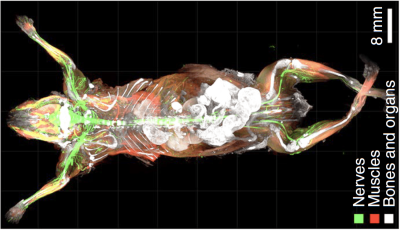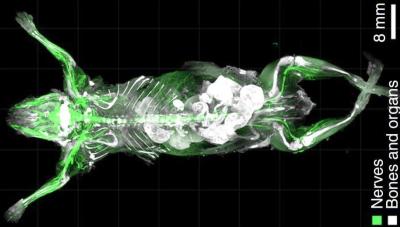Transparent mice map the brain’s washing machine
Thanks to an ingenious technique – which is able to make tissue transparent – Danish researchers have discovered a ‘plumbing system’ that rids the brain of waste products. While we sleep.
This is shown by new research recently published in the scientific journal Nature Neuroscience.
The findings came to light in studies of the brains of mice. However, since both mice and human beings are mammals, ‘we can obviously expect to find a similar system in the human brain’, says Maiken Nedergaard, Danish neuroscientist and professor at the University of Copenhagen, Denmark, and the University of Rochester, USA.
The main theme of a research article published in 2013 in Science – one of the world’s most prestigious scientific journals – was that the brain disposes of waste products while we sleep.
This article was written by a team of neuroscientists headed by Maiken Nedergaard, and their main point was that our brain opens during sleep and is flushed through with cerebrospinal fluid. And when the fluid later runs out of the brain through nerves and lymphatic vessels, the brain’s waste products are washed out with it.
Basically, this process can be compared with a washing machine. However, Professor Maiken Nedergaard explains that, up to now, some important details have been missing from the puzzle:
‘We didn’t know what the plumbing of the vascular system that handles this process actually looked like. None of the scanning techniques previously available to us were able to figure out this hydraulic system in the brain. But thanks to the new technique, which makes the skull transparent, we can now begin to see the brain’s plumbing system. The studies in mice showed, among other things, that mammals have lymphatic vessels connecting the brain directly to the skull! We usually remove a brain to study it, but when we do this we cut through these vessels.’
According to Maiken Nedergaard, this new technique is a quite remarkable development: ‘And it may be hugely significant for research into many of the diseases in human beings which involve and affect brain processes – such as Alzheimer’s and psychiatric disorders. It’s also important to gain a better understanding of these diseases if we’re to design drugs based on principles other than those applied to the drugs we offer today.’
Stripping the fats
vDISCO is the new technique that makes tissue transparent. It was developed by Turkish neuroscientist Ali Ertürk who researches in strokes and dementia at the Ludwig Maximilian University of Munich in Germany. Ertürk is also the leader of the scientific team behind the new article in Nature Neuroscience.
Basically, Ali Ertürk has discovered how to strip dead tissue of fats and pigments using a cocktail of organic solvents.
To make a mouse transparent, he first has to kill a laboratory mouse. When the fats and pigments have been removed, the mouse shrinks. It becomes hard, almost like plastic.
Ali Ertürk now has a dead body with organs and blood and lymphatic vessels intact, and he can examine it under sophisticated microscopes.
He can follow the various paths around the organism and see where and how the cerebrospinal fluid spreads in the brain. He can also study whether a tumour in the brain creates reactions in cells in other parts of the body.
The clever thing about this examination technique is that all organs and plumbing systems are intact, because nothing has been surgically removed. And special structures, also developed by Ali Ertürk, can be used to provide the answers the researchers are seeking.
These structures are, in principle, minute spheres which are able to penetrate anything. A classic technique is used to make them fluorescent, and therefore they glow green when struck by laser light from a microscope. In the laboratory, it is also possible to manipulate the tiny structures to seek out and bind to specific cells or proteins in the transparent mouse.
‘It really is a brilliant examination method that Ali Ertürk has devised. And when I became aware of it a few years ago, I contacted him and asked if he could help us take a closer look at the plumbing in the vascular system that cleanses the brain while we sleep,’ Maiken Nedergaard explains. Together with Anna Xavier, a postdoctoral fellow at the University of Copenhagen, Maiken Nedergaard prepared the samples Ertürk needed to look for the special vascular system.
Tests on people?
The lymphatic vessels that connect the brain and spinal cord to the skeleton are truly microscopic, and Ali Ertürk was suddenly able to see them with the help of the transparent mice.
They would never be detected if the mouse brain was removed from the skull, and Maiken Nedergaard explains that the same applies to human beings.
To use vDISCO to examine these lymphatic vessels in humans, researchers must be given the necessary access to research on corpses. Naturally, this raises a number of considerations – some ethical in nature. However, the idea of using the technique to examine the exceptional washing machine in the human brain is certainly logical from a purely scientific point of view. Maiken Nedergaard explains:
‘As a neuroscientist, there are several issues I would like to investigate further. One of these would be how time – the course of life – affects the brain’s cleansing system, the glymphatic system. Could it be, for instance, that this system is different, and passage through it is poorer, in the elderly than in young people? And how is the glymphatic system of, for example, Alzheimer’s patients compared with that of people of the same age who don’t suffer from dementia? What happens to the system when you bump your head? And might it be that severe depression affects this plumbing system? There’s enough to get started on,’ says Maiken Nedergaard.
The new article in Nature Neuroscience was written in collaboration between Ali Ertürk, a number of German and American researchers – and Maiken Nedergaard and Anna Xavier. The work was financed by, among others, the Fritz Thyssen Stiftung, Germany, National Institutes of Health (NIH), USA, and the Lundbeck Foundation, which funds Maiken Nedergaard’s research.

